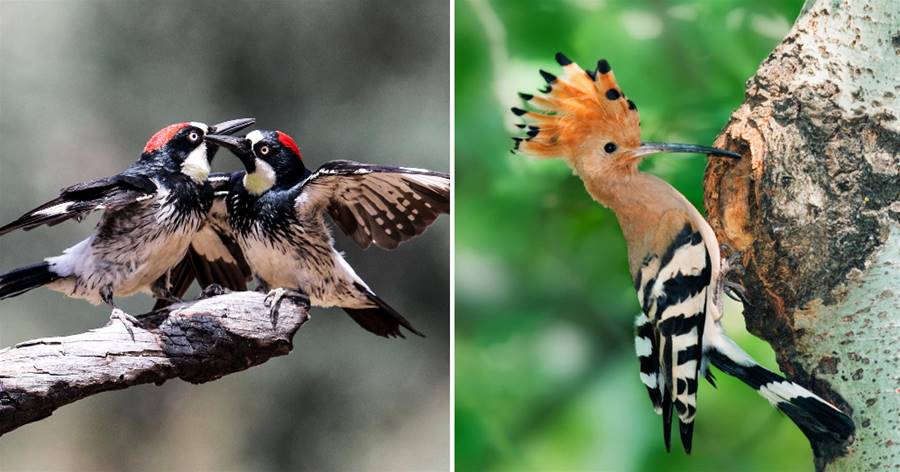


Woodpeckers have a special bone in their head called the hyoid bone. This special bone unique to woodpeckers wraps around their entire skull inside their heads and adds a sort of shock protection.
This protects them from “headaches” or injuring themselves when they are repeatedly smashing their heads up against a tree, sometimes for hours.
While most woodpeckers are certainly capable of boring a hole through a live tree, many times they prefer dead trees.

Woodpeckers may also like the taste of the sweet . This past Spring and Summer, I had more Downy Woodpeckers at my hummingbird feeders than I did actual hummingbirds!
Many different types of birds have their own names when it comes to a group, or flock, of them.

There are only a few types of birds with really long tongues that wrap around their eye sockets allowing them to extend them out much further than other birds.
Woodpeckers along with hummingbirds and even orioles are among these birds with long tongues. These special adaptations allow all 3 of these types of birds to drink from hummingbird feeders.

Most of the time woodpeckers are solitary birds, but the Acorn Woodpecker has a very intricate social and family structure with other woodpeckers.
Unlike other types of woodpeckers, Acorn Woodpeckers will live in groups of 10-16 other birds. They will cooperatively breed within the group, hoard food by jamming nuts into holes in trees, and work as a team to guard their food caches by using warnings signs and communication with each other.
Unless you count the Ivory-billed Woodpecker, which is long thought to be extinct but not yet officially extinct, Pileated Woodpeckers are the biggest. They are around 16-19 inches in length and are about the size of crows.

They are impossible to mistake for other types of woodpeckers because of their size and appearance, though people sometimes mistakenly call them Red-headed Woodpeckers which are another species and are much smaller.
Woodpeckers are diurnal animals, so they roost at night and are mostly quiet.

As I mentioned above, everyone in the woodpecker family has an exceptionally long tongue, this includes sapsuckers. Members of the sapsucker variety don’t actually suck the sap though, they bore out sapwells in trees then they stick their long tongues in and sip and lick at the sap.
Even though many people may think that woodpeckers eat wood, similar to how beavers eat wood, they actually don’t. Woodpeckers simply use their beaks as a tool to dig out holes into wood which allows them to excavate nesting holes or get insects and insect larvae from the hole.

Some species of woodpeckers, like the Great Spotted Woodpecker, are omnivores and will even eat other bird eggs or babies on occasion. A Gila Woodpecker was caught on camera killing and eating baby bird’s brains in a nest.
For most woodpeckers though, they generally keep to themselves and are not aggressive, however they will protect themselves and their own young fiercely if necessary.
No one seems to agree just how many species are in the family , but one things is clear, there definitely over 200. Brittanica.com says that have been recorded, Wikipedia cites that the International Ornithological Society reports that have bee discovered. While other sources such as PSU.edu are saying exist..

Most types of woodpeckers have Zygodactyl feet that are highly adapted for climbing. Zygodactyl feet have two toes in the front and two toes in the back which allow the woodpecker to grip the tree in a way that allows very quick vertical and horizontal movements, as well as increased leverage for pecking.
The Gila Woodpecker lives in the Sonoran Desert in parts of Southern California, Nevada, and Arizona. These hardy woodpeckers have adapted to life in the desert and will nest in the giant saguaros.
The , reach heights of 50 feet tall, and weight 5000+ pounds when it’s fully hydrated.

Woodpeckers regularly do something called “drumming” on metal gutters, and it can be very loud. They do this for several reasons, mainly to mark their territory or attract a mate. So if you hear or see a woodpecker drumming on your gutters then you may have a breeding pair nearby.
Woodpeckers, unlike other birds, have special regenerative cells at the end of their beaks so they are constantly regrowing if needed.

Many times woodpeckers are associated with wisdom and knowledge, but in traditions of eastern Slavic people, a woodpecker can symbolize death or bad luck. A woodpecker’s drumming is said to announce a death.
So if you want a spiritual meaning of what the drumming on your gutters means, there you go. As we mentioned above though, the drumming is for communication.